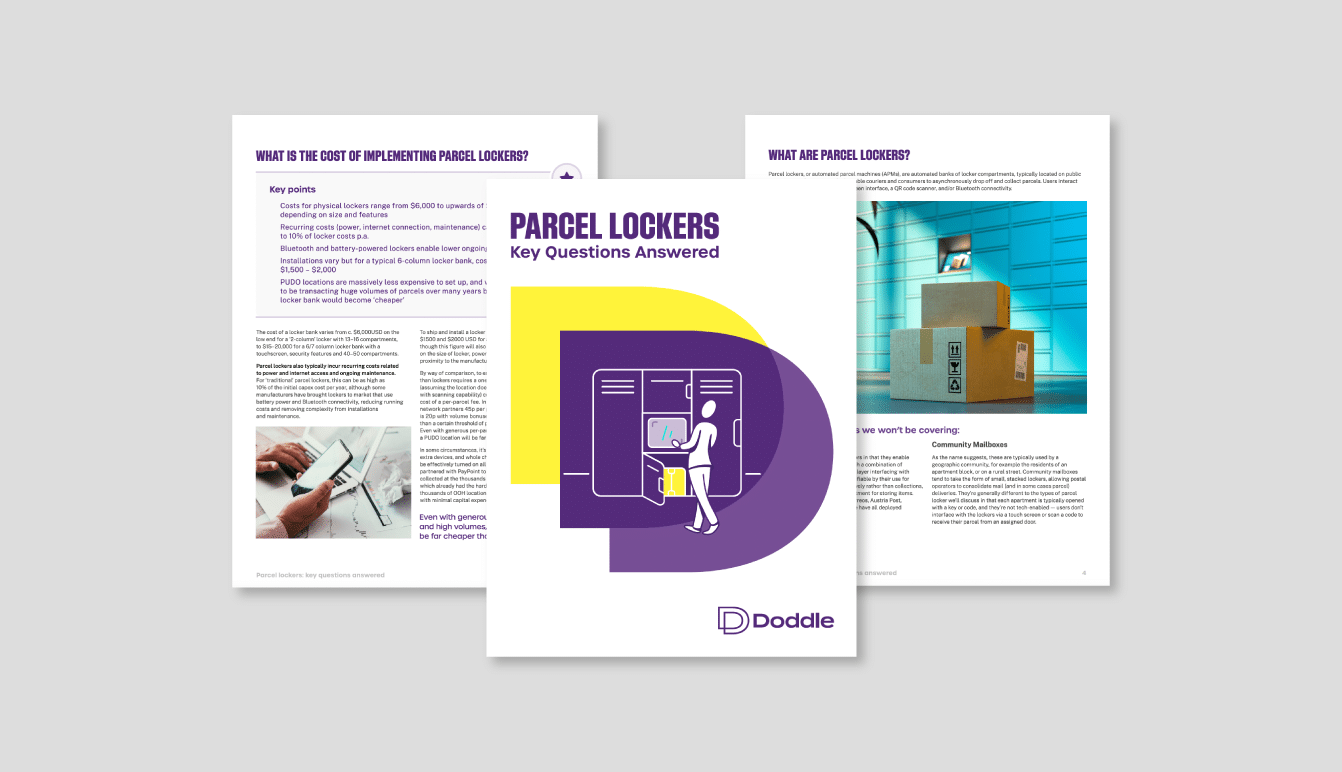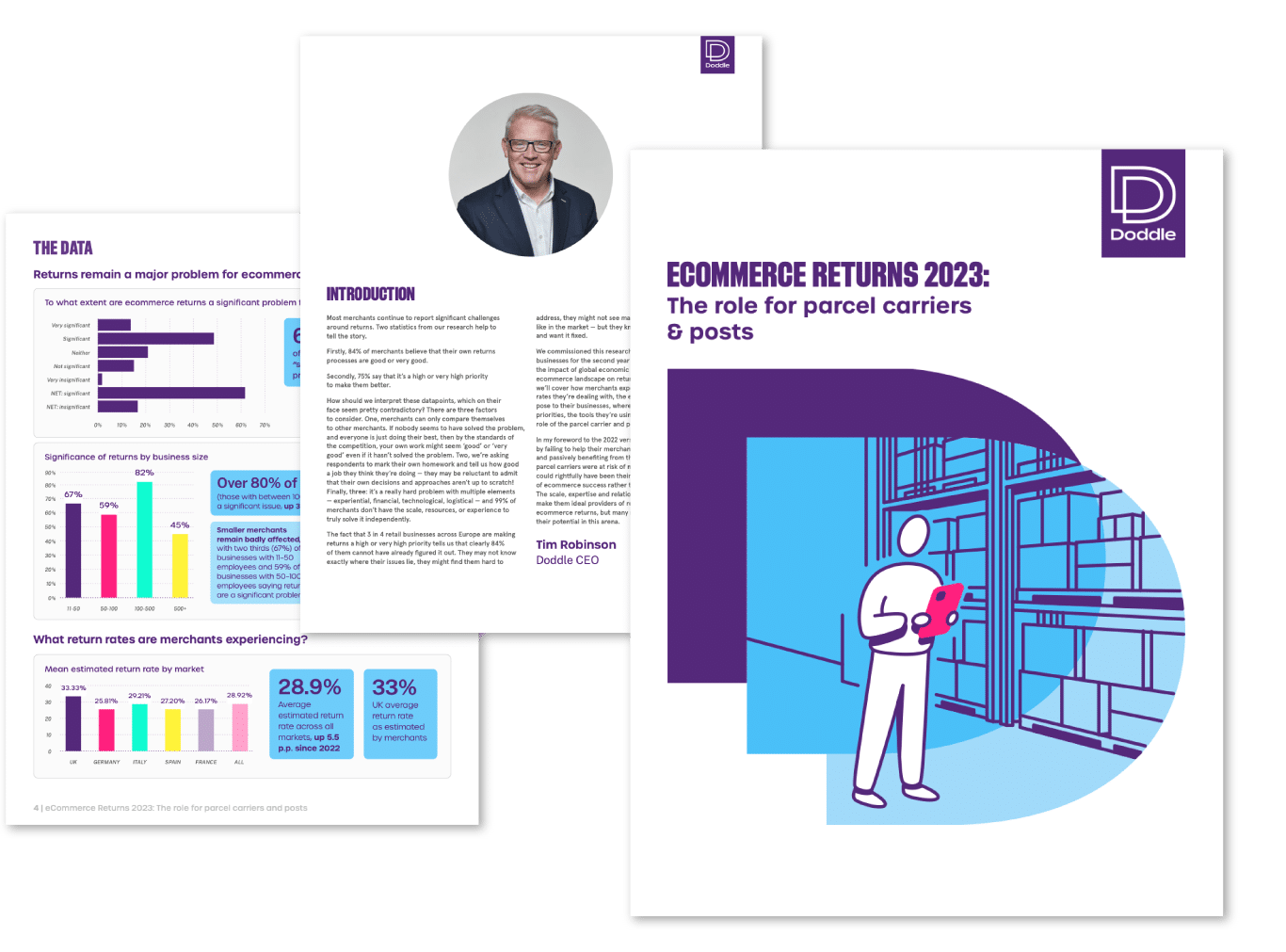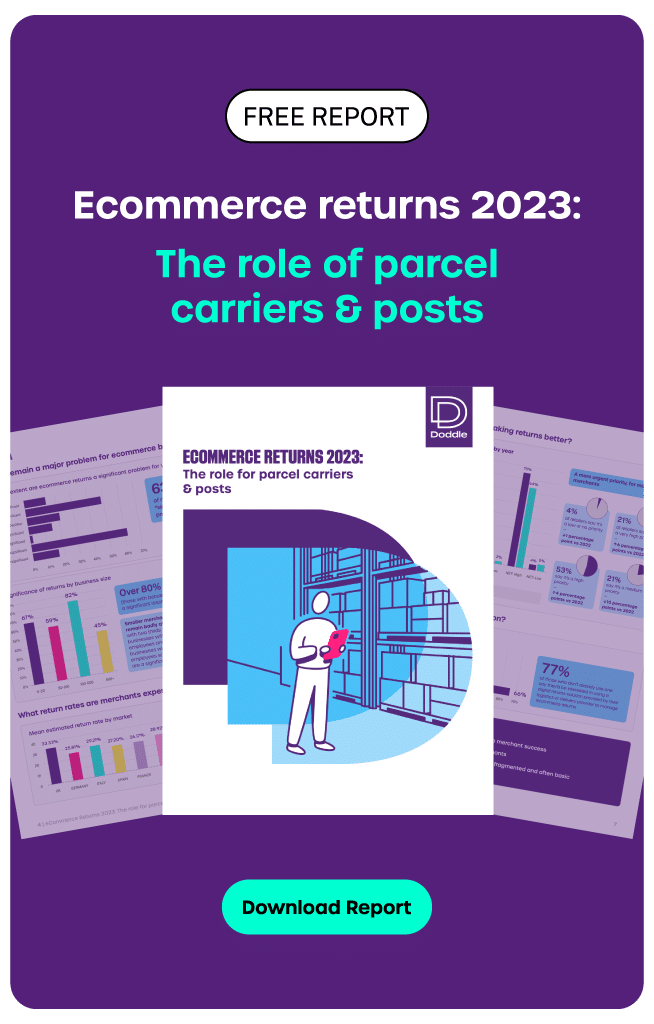Insight / Blog
5 Changes We Predict in eCommerce Delivery & Returns in 2024

Summary: Our predictions for 2024 in ecommerce delivery and returns, plus a roundup of our 2023 predictions.
None of us know for certain what the future holds, but that’s never stopped us here at Doddle enjoying a bit of educated guesswork at the turn of each year. Starting in January 2020 we’ve had some fun thinking about what might happen in the next 12 months of ecommerce – and ever since January 2021 we’ve also had to hold our past predictions up to the often-unforgiving light of the present.
So what did we say was coming down the pipe for 2023, and how right or wrong were we? And what change is afoot for 2024?
Marking 2023’s predictions
1. Logistics giants reach down to the consumer – 5/10
We watched in late 2022 as CEVA Logistics bought Colis Prive, extending its reach from container freight right down to the last mile, and we thought, “that makes sense”. So much so that we figured it would be a continuing trend into 2023. What we actually saw was probably more like the tail end of a brief period of interest by the big logistics players in acquiring last-mile capabilities.
However, our shout wasn’t entirely wrong – GXO’s acquisition of PFSweb in the US falls into this category, and looking more broadly at global supply chain operators reaching down to the consumer, there’s been activity in the returns space: UPS just acquired Happy Returns, securing its network of drop-off locations and its digital returns booking platform.
And of course, in what is undoubtedly the biggest global supply chain acquisition news of the year (in our office, at least): Blue Yonder acquired Doddle to enable its truly end-to-end supply chain proposition, now including returns management and reverse logistics.
2. Cities take control – 7/10
We wrote that 2023 would be a year in which “cities around the world look to transform their infrastructure, forcing carriers to adapt and collaborate with authorities”.
There have been fewer explicit regulatory approaches than it first seemed might be likely at the start of the year, when Barcelona’s city council approved a proposal to tax merchants 1.25% of their profits for “using public space to delivery products purchased online”. That only applies to home deliveries, with consolidated PUDO or locker deliveries not paying the charge. It’s not clear how much impact this has driven, but demand for out-of-home delivery options should be increased by this measure.
One reason why there have been fewer explicit measures around delivery is the boom in transport and access regulations in cities across Europe. The introduction, expansion and tightening of requirements of their low emission or zero emission zones has been in overdrive in the past few years – this interactive map shows the current extent of city-based regulations across the continent.
That affects parcel carriers’ last-mile operations already, and authorities may feel that these regulations are sufficient without needing to address the parcel delivery market specifically.
We’ve also seen strong evidence that carriers opting to get ahead of the curve and collaborate. DPD has been eager to talk about its approach to green city deliveries, having accelerated its timeline to reach 25 “all-electric” towns and cities (including Britain’s 10 biggest cities) to the end of 2023.
Similarly, YEEP is a new locker business launched in the UK this year, and its website notes existing contracts with London Boroughs, as well as plans to make lockers available to other local authorities, pre-empting local government interest in solving last-mile delivery issues.
3. Returns get rationalised
There were two specific parts to this prediction. Firstly: “…we expect to see more carriers offer a consolidated returns service in 2023.” And secondly: “By the end of the year, we think ASOS will be charging for at least some of its returns, by some of its customers, some of the time.” The context: ASOS had made statements indicating its desire to retain a universal free returns proposition, believing it made strategic sense, even as some big competitors like Zara were moving to charging consumers for returns.
For the carrier prediction: two of the biggest carriers in the US and the world, Pitney Bowes and UPS, made clear in 2023 that they were following FedEx’s lead on consolidated returns. Pitney is now offering consolidated shipping rates directly in merchants returns management platforms, and UPS acquired Happy Returns’ drop-off network to improve its returns consolidation.
UPS CEO Carol Tomé“…we’re going to offer consolidated returns for our customers, which will reduce their handling costs.”
On the merchant side, ASOS introduced returns charges for returns made after more than 14 days, incentivising shoppers to get their items back to the retailer faster, which in turn makes those goods easier to sell at or near full-price and reduces inventory costs. Which, for our money, makes that two bang-on accurate predictions for the price of one.
4. Delivery management becomes a consumer product
It’s hard to say that there was a great deal of movement from 2022 to 2023 – the same solutions remain in the market and there hasn’t been an influx of competition or a clear winner in the space. Anecdotally in the Doddle office, Shopify’s “Shop” app has gained ground, with multiple people finding that it had started tracking their shopping without them realising or expecting it – thanks to its integration with Shopify’s Shop Pay. But overall? We can’t call this a win.
One line of our prediction did ring very true, however: “We expect consolidation in the post-purchase/returns/consumer-facing order management space, with mergers and acquisitions, including potentially a major carrier acquiring a provider to accelerate their own digital transformation.”
UPS acquiring Happy Returns fits this to a T. Blue Yonder acquiring Doddle, adding post-purchase and returns management to its existing suite (including order management), arguably fits the bill too. But as a consumer app? It seems that managing multiple deliveries from different merchants for consumers to easily track and plan around is just not enough of a moneymaker to exist as a standalone product.
5. The pre-eminent locker business leans into PUDO in the UK
InPost had (and still has) big ambitions for the UK, and it seemed clear to us that in order for it to reproduce its successful Polish model in the UK it would need more than just a great locker network in major cities. Starting to pick up real outbound delivery volume requires nationwide reach, which requires distribution and the ability to scale up a lot of new locations quickly. That requires PUDO.

And so, InPost’s purchase of a stake in Menzies Distribution and the launch of its branded PUDO network in the UK didn’t come as huge surprises, but both are important milestones for its growth.
2024 predictions
1. Audience segmentation comes to returns
89% of retailers have moved to introduce or increase returns charges, or tightened their policy by shrinking the length of time in which returns can be made, in the last 12 months. Given that we know many retailers, even those with significant revenue, are still stuck with heavily manual returns processes, we can infer that a lot of that shift away from free returns has been driven by guesswork and a look over at what the competition is up to, rather than first-hand data.
In 2024, retailers will need to do better than follow the crowd or make a guess when it comes to setting up their returns propositions. They’ll need to make strategic choices based on their own data, which will require many to build or buy new tools to digitise some or all of their returns management.
The upside is that by doing so, they’ll no longer need to swing from maximum customer acquisition to maximum cost-reduction and back. Instead, they can find the right balance for their customer and product to ensure new customers feel confident to purchase and won’t be put off by the experience of a return, without experiencing huge costs of uncontrolled returns. They’ll be able to segment their customer base and treat returns much more like they treat marketing – not with a one-size-fits-all offering, but with targeted propositions designed to maximise profitability.
That will mean that free returns will make a comeback – for those businesses for whom they make sense, and with the right restrictions that prevent them becoming an overall detriment to margins.
2. Returns Part 2: The long tail wags
As a corollary to the return of free returns, while the first step for most retailers was to add or increase fees and tighten policies, the next steps will have to involve some upgrades to their technology stack to make more strategic returns decisions possible.
For the long tail of smaller ecommerce retailers, this will mark the first time that they move to a digital platform to manage returns, stepping away from returns initiation methods that involve calling customer service for authorisation, or being pointed to a parcel carrier website to get a shipping label, or having returns shipping labels included in every outbound parcel.
We expect to see a drop in the share of merchants using these outdated returns initiation methods in 2024 as returns digitisation reaches the small and medium sized businesses. That might happen with the support of parcel carriers, who have the incentive to provide digital returns as an added value service, because it captures more returns parcel volume and retains additional customers.

3. Vinted pushes the limits
C2C commerce has been a massive story for the first and last mile in the last couple of years, and Lithuanian business Vinted has been at the forefront of that expansion, reaching 16 markets with tens of millions of active users. What’s interesting is that unlike eBay’s approach where sellers can configure extensive postage tables for their listings, Vinted takes out a lot of complexity with the shipping by relying on a few key partners. The seller simply picks from a list of available shipping providers to offer to customers.
Another remarkable stat about Vinted is that over 70% of its customers receive parcels through out-of-home deliveries, well above the average for B2C ecommerce in any of its markets, and many times higher than average for markets like the UK. That is part of its success – with very low item values, it couldn’t afford for shipping to be expensive, and needed significant consolidation to keep costs low.
The combination of C2C exploding in popularity and its reliance on out-of-home delivery will continue, and it will drive wider consumer awareness and first-time-usage of out-of-home delivery options, which will incentivise further investment by parcel carriers into their out-of-home networks.
Vinted already has its own subsidiary, VintedGo, in France, which is a proprietary shipping solution offering consumers the ability to make locker-to-locker (or PUDO-to-locker, et cetera) shipments. In 2024, we expect VintedGo to expand into new territories like Italy and Benelux, as well as opening the service up to accept non-C2C volume, becoming a partly agnostic OOH network in its own right.
4. Resale adoption creates new challenges for retailers to manage
The global secondhand market is expected to nearly double by 2027, reaching $350 billion, per ThredUp. Brands are taking notice – their products are resold, sometimes for significant value, and they don’t get a cent. At the same time, consumers have to be cautious when it’s not a brand they’re buying from, but another shopper. As much as marketplaces have done to make that process more reassuring, there’s still space for retailers to get involved and benefit.
Brands like Patagonia, Levi’s and Lululemon have already created dedicated resale channels, but the majority of top retailers aren’t there yet. However, with second-hand apparel expected to grow three times faster than the overall apparel market, 2024 will see many more jump on board.
However, taking on a peer-to-peer recommerce model under their own wing can be challenging for brands, who suddenly need to provide the infrastructure to make this happen. Alternatively, brands can allow consumers to trade in no-longer-wanted products. However, this puts additional strain on the existing reverse logistics process, and for the whole resale to be worthwhile, the process of getting items back from consumers to the brand has to be extremely efficient. This year, we expect to see more retail brands to launch resale channels, and require new logistical and technological services to manage them.
5. Multiple leading posts announce reduced USO
Post Danmark was released from its universal service obligation (USO) in 2023, and with letter volumes in structural decline across the board, posts, governments and regulators have been evaluating the statutory responsibilities which postal operators are subject to. In 2024, expect to see a handful of countries follow Denmark’s lead in at least some capacity. Ofcom, the UK regulator, recently announced proposals to reform Royal Mail’s letter delivery obligations both in terms of which days the service would deliver and the speed of 2nd-class deliveries.
While this will be contentious in some countries, it’s inevitable that as fewer and fewer letters are sent and less and less crucial information is exclusively dealt with on paper, having a universal letter service 5 or 6 days a week will become a less valuable public good, so reliability and sustainability will be prioritised over speed and delivery days.
Let us know your thoughts on these predictions, and feel free to share your own with us on LinkedIn – and if you need technology and expertise to help you navigate the changing world of ecommerce delivery and returns, don’t hesitate to get in touch.
Related articles
How 3PLs Can Cut Costs, Reduce Waste and Boost Revenue With Smart Returns Management
3PLs should take advantage of returns to help reduce cost, efficiently manage warehouse resources, and aid growth.
Saving profits and the planet: 4 ways to sustainable & cost-effective returns
Returns drain profits and damage sustainability. Luckily, retailers can implement both cost-effective and sustainable returns using these 4 ways.
Return fees or free returns: why not both?
Debates between return fees or free returns miss the bigger picture: how to address the root issues of returns.












